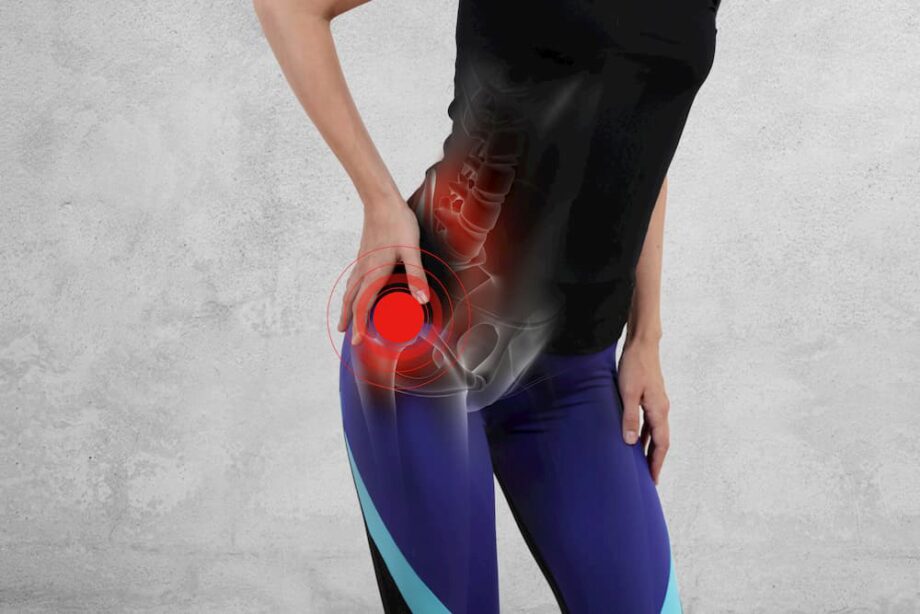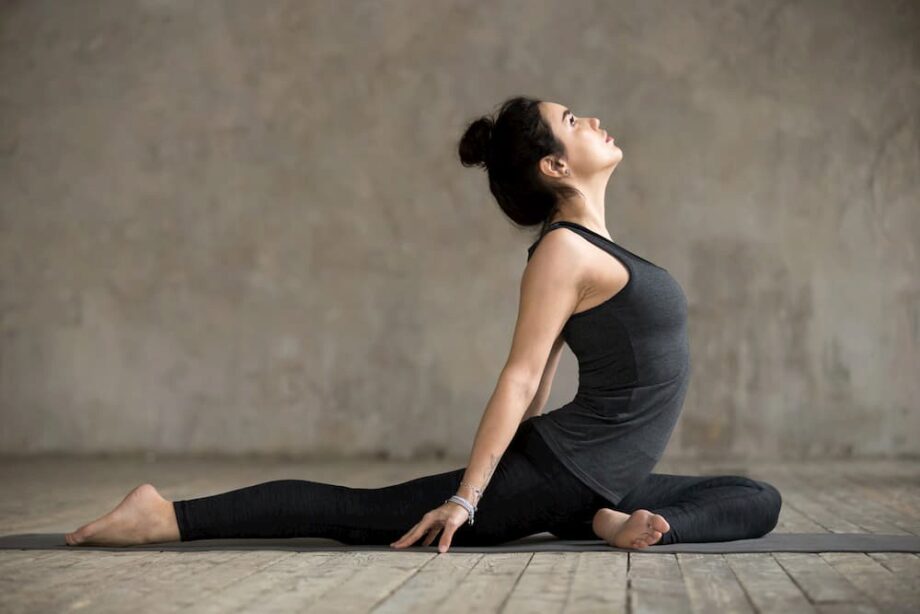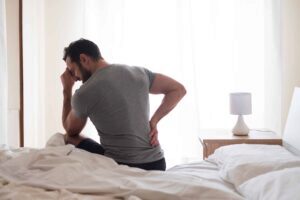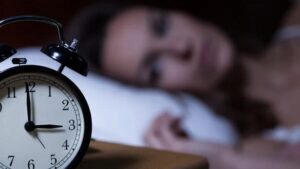Hip Pain and Sleep
Disclosure: By clicking on the product links in this article, Mattress Nerd may receive a commission fee at no cost to you, the reader. Read full disclosure statement.
Mattress Nerd consulted Vivian Eisenstadt, MAPT, CPT, MASP, to ensure that this article met our editorial standards
The hips are a complex body part with a big responsibility. They support the weight of the body and provide movement and stability. Our hips enable us to walk, squat, and climb stairs. And like most body parts, when they’re working properly, we don’t think much about them. But when hip pain strikes, it can be debilitating, hampering our daily activities and disrupting our sleep, according to a study on hip pain published in BMJ. When sleep is impacted, it can take a toll on your physical and mental health, increasing your risk of high blood pressure, diabetes, heart disease, dementia, and depression.
If you suffer from occasional or chronic hip pain, you are not alone. It’s a common complaint among older Americans, but it can affect people of all ages. Painful hips can be caused by a number of ailments, including fracture, arthritis, inflammation, strain, or injury. Depending on the source of your pain, the discomfort can be felt in the thigh, groin, buttocks, or inside or outside the hip joint. The type of pain can vary too, ranging from a dull ache to sharp pain, and can also feel like a pulled groin muscle or even a backache.
While treatments can make hip pain manageable during daily activities, nighttime can be especially bothersome to hip pain sufferers, says Dr. Steve Knauf, executive director of chiropractic and compliance for The Joint Chiropractic, the nation’s largest provider of chiropractic care. “Some sleeping positions put a lot of stress and strain on the hips at night that can aggravate symptoms and make hip pain worse,” he says. “Pain is almost always related to inflammation, and inflammation can build in an area while sleeping. Bursitis and tendonitis are two common reasons for hip pain caused by inflammation.”

Sleep Solutions for Hip Pain
Hip pain can be a real pain, but there are strategies you can put in place to help you enjoy a good night’s rest.
Sleep Position
If you find yourself tossing and turning at night to find a comfortable — and less painful — position, consider these strategies based on your sleeping position.
Side sleepers
Most people prefer to sleep on their sides, but this can be especially painful for people with hip pain. “This can either be due to the compression of the downside hip into the mattress or, more commonly, excessive tension on the muscles of the upside hip,” says Dr. Jordan Duncan, owner of Silverdale Sport & Spine, a clinic specializing in difficult-to-treat musculoskeletal pain conditions located in Silverdale, Washington.
The upper leg also puts extra weight on the lower leg, which causes the hips to shift and strain. If you’re a side sleeper, try placing a pillow between the knees to help alleviate some of the pressure in the hips and lower back while also helping keep the spine in alignment. “This decreases strain on the hip and associated muscles, which can become excessively stretched if the lower extremity is allowed to fall inward when side-lying,” Dr. Duncan says. “Here, you would sleep with your painful side up.”
Back sleepers
Chiropractors agree that the best sleeping position is on your back; this is especially true for back pain sufferers because it helps maintain spine alignment. But it does have its drawbacks. Back sleepers are more prone to snoring and may experience bouts of obstructive sleep apnea. For comfort, try tucking a small pillow or bolster under your knees to take pressure off your back and buttocks, as well as the front of the hips. A modification of this is to place a pillow under your thighs the long way starting from half way down your buttocks. This can open the front of the hip joint if that is where the pain is originating.
You can also slightly raise your head with a wedge-shaped pillow to reduce the risk of snoring and lessen episodes of sleep apnea. By elevating the head and the knees at the same time, you can create a zero gravity position, which mimics the weightless, pressure-free sensation of floating in space. This position can improve blood flow, reduce swelling, and lessen pain.
Stomach sleepers
If you’re a belly sleeper, “find a way to switch to sleeping on your side or your back,” Dr. Knauf cautions. Sleeping on your stomach is considered the worst sleeping position, according to the International Chiropractors Association. While it may appear to be more comfortable on the hips compared to side sleeping, stomach sleeping “may contribute to stress in the lower back, extending into the hips, legs and feet,” causing you to wake with lower back pain, shoulder stiffness, acute neck pain, and a headache. If you must sleep on your belly, try placing a thin pillow under the abdomen to help ease the strain in your lower back.
Invest in a New Mattress
Your mattress could be worsening — or even causing — your hip pain. Mattresses that are too soft, too firm, or don’t have enough support can leave you in pain regardless of your sleeping position or the pillows you use.
A new mattress made with memory foam is one of the best options for people with hip pain. Memory foam is known for its cushioning, contouring comfort, which is a godsend when it comes to side sleepers. These mattresses distribute body weight that allows more sinkage at the shoulders and hips, which helps ease pressure at these sensitive pressure points. Memory foam also helps keep the spine aligned to prevent backaches.
You’ll also want to be sure your mattress isn’t too soft or too firm. “If someone sleeps on their back on a hard mattress, it can cause the lower back to flatten into the sleeping surface, which creates flexion of the lumbar spine,” Dr. Duncan says. “This problem can be helped by sleeping on a medium-firm mattress, which provides support to the contours of the lower back.”
If a new mattress isn’t in your budget, or if your current mattress is supportive enough but doesn’t have the cushioning pressure point relief you need, consider a memory foam mattress topper. These toppers come in various thickness options, and some even come with cooling technology.
Stretches and Exercises for Hip Pain
Nightly stretches can do wonders to help hip pain sufferers sleep better, says Dr. Farzin Kabael with DOCS Spine + Orthopedics in Beverly Hills, California. Especially if the pain is in the buttocks area or the back of the hip. For this pain, “I recommend nightly stretches and a foam roller,” he says. “The foam roller provides direct pressure to the muscles and tendons, releasing tension and relaxing spasms that can be caused by overuse or, as I call it, fatigue.”
To avoid injury or further aggravating your hip, warm up your muscles before stretching by doing some gentle exercises, such as walking. Hold stretches for about 10 to 30 seconds and only to the point of mild discomfort. If it hurts, you are pushing too hard!
Here are some stretches and exercises to help you get started.
- Butterfly stretch: This is a great, basic stretch for your inner thighs and groin. Start by sitting upright on the floor. Then bend your knees outward and bring the soles of your feet together. Grasp your ankles and drive your knees into the floor.
- Hip flexor stretch: The hip flexors are a group of muscles near the top of the thigh. They can be painful when they tighten up. To stretch out your hip flexor, get on your knees and bring one leg forward like you’re about to propose. Keep your upper body straight and lean your hips forward until you feel a stretch at the bend of the leg where it meets the abdomen. Repeat with the other leg.
- Pigeon pose: This stretch opens the hips and eases tension and pain. Start by lying on your back with both knees bent. Lift your right leg and place your ankle on the top of your left knee until you feel the stretch in your hip. Repeat with the other leg.
- Hip bridges exercise: This exercise is great for strengthening your hips, glutes and core. Start by lying on your back with your knees bent and your arms by your side. Lift hips off the floor as high as you can, hold, then lower your hips back to the floor slowly. Repeat.
- Lying lateral leg raises exercise: This basic exercise helps stretch out the glutes. Start by lying on your side with your legs straight. Lift the top leg up and down, keeping your legs straight. To stretch the hip flexors, slightly turn the toe on the upper leg down toward the floor. Be sure not to let your body roll forward or backward while you lift your leg. Repeat with the other leg.
While stretches can ease pain and help you sleep better, they may not be for everyone. For those with pain in the groin area or front of the hip, “it is much harder to find a comfortable position or to simply stretch it out,” Dr. Kabael says. “In those cases, I recommend over-the-counter analgesics and a call to a good orthopedic surgeon for an evaluation, as [those pains] tend to be a sign of possible labral tears or joint arthritis.”

Practice Good Sleep Hygiene
Sleep hygiene involves the behavioral and environmental practices surrounding your sleep. Good sleep hygiene helps ensure a restful night’s sleep whether or not you suffer from hip pain. Here are some ways you can improve your sleep hygiene.
Nighttime routine: Establishing a nighttime routine is a great way to prepare young children for bedtime, but it’s also a good way for adults to wind down so they can fall asleep shortly after their heads hit the pillow. Begin about 30 minutes before bedtime by taking a warm bath, listening to soothing music, and meditating or doing yoga.
Bedroom environment and room temperature: Your bedroom should be conducive to sleep. Block out obtrusive light with darkening shades or use a sleep mask, counter outside noises with a noise machine, and set your thermostat to a comfortable temperature a few degrees lower than you set it during the day. Be sure your bed linens are clean and cooling and your pajamas are comfortable and not too restrictive.
Limit alcohol/nicotine use before bed: A nightcap may help you fall asleep at night, but too much before bedtime limits restorative REM sleep and can leave you wide awake at 2 A.M. You might want to rethink that cigarette before bedtime as well. Nicotine is a stimulant and can leave you awake at bedtime.
Avoid blue light too close to bed: Blue light that emits from electronic devices such as laptops, smartphones, and TVs stimulates the brain, which is great during the day. But at bedtime, blue light can leave you restless when it’s time to fall asleep. Try unplugging at least 30 minutes before you plan to go to sleep to allow your brain to settle down.
Causes of Hip Pain
Hip pain varies depending on the source. If you suffer from persistent or acute hip pain, you will want to visit your doctor for a diagnosis. Knowing the source of your pain can help identify your treatment. Here are some common causes of hip pain:
Osteoarthritis: Also known as OA, osteoarthritis is a common degenerative joint disease that occurs when the cartilage at the ends of the bones wears down over time. Symptoms include a dull, aching pain and stiffness in the groin, outer thigh, knee, or buttocks that is worse in the morning or after sitting for a while. The pain lessens with activity.
Bursitis: Bursitis is the inflammation of the tiny fluid-filled sacs in the joints called bursae. A type of bursitis, called trochanteric bursitis, can affect the hip’s outer area from the hip to the knee along the thigh. Symptoms include pain on the outside of the hip that gets worse when you stand, walk or run.
Rheumatoid arthritis: Also called RA, rheumatoid arthritis is a chronic inflammatory disorder that affects the joints, usually the hands and feet, but it can also affect the hips. Symptoms include severe pain, stiffness, and swelling in the thigh and groin.
Sciatica: Sciatica refers to the pain that radiates along the sciatic nerve, which runs down one or both legs from the lower back. It’s usually caused by a herniated disk or bone spur pressing on the nerve. Symptoms include pain that originates in the spine and radiates down the back of the leg. It usually only affects one side of the body. “The dull pain [of sciatica] may be hard to pinpoint, leading someone to believe the pain is coming from their hip,” Dr. Knauf notes.
Pregnancy: Hip pain is a common complaint among pregnant women, especially as they enter the third trimester. “Pregnancy causes the joints and ligaments to become more flexible,” Dr. Knauf says. “This may also lead to instability and extra stress on your joints. Using a pregnancy pillow is an excellent way to add support while sleeping.”
Final Thoughts
Hips are a complex body part, and when they hurt, the pain can be debilitating, especially at night when you’re trying to sleep. If it causes you to suffer a sleep deficit, it can affect your physical and mental health. There are strategies you can put into place to reduce your pain so you can sleep better. If those tactics don’t work or if your pain is undiagnosed, make an appointment with an orthopedic doctor to determine your source of pain and the best treatment options.
Meet Our Medical Reviewer
Vivian Eisenstadt, MAPT, CPT, MASP Vivian Eisenstadt is the founder of Vivie Therapy. Her private practice helps individuals with chronic and recent pain reclaim their lives quickly and thoroughly. Prior to founding her own practice, Vivian served as a Physical Therapist at Cedars-Sinai Medical Center. She specialized in treating spinal injuries, postural dysfunctions, sprains and strains, and general orthopedic injuries.


